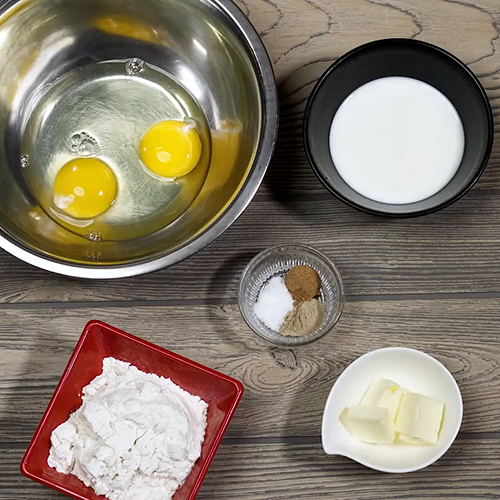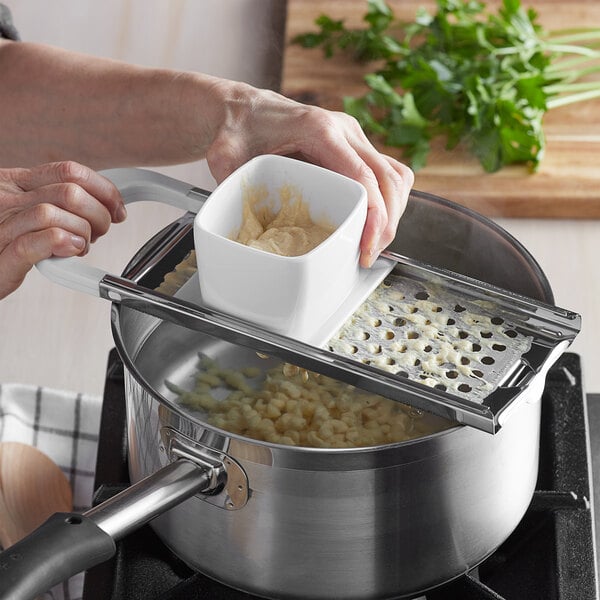If you're a fan of German cuisine, then you've probably heard of spaetzle. This traditional German dish is often described as a cross between noodles and dumplings. In Germany, spaetzle is a popular comfort food enjoyed during the colder months. It is also a staple at Oktoberfest parties and other celebrations. Making spaetzle from scratch may seem intimidating, but it is simple and requires only a few ingredients. Our easy spaetzle recipe is a great side dish for a variety of traditional German meals and pairs well with sauces and gravies.
What Is Spaetzle?

Originating from the Swabian region of Germany, spaetzle is German egg noodles that are similar in shape to small dumplings. The word "spaetzle" means "little sparrows" in German, which is a nod to its small, irregular shape. It is also commonly called spatzli, spatzen, and knopfle. Traditionally made with just a few simple ingredients, including flour, eggs, salt, and water, spaetzle is a versatile dish that can be enjoyed as a side or main course.
How to Pronounce Spaetzle
The German pronunciation of spaetzle is schpetz-luh. However, it is not uncommon to hear the Americanized pronunciation of spat-sl.
How to Make German Spaetzle
Making spaetzle from scratch is quick and easy, which is why it is such a popular dish in central Europe. Spaetzle is made from a simple batter of eggs, flour, and salt, which is then pushed through a spaetzle maker to create small, irregularly shaped noodles. These noodles are then boiled until they are tender. Watch our video tutorial for spaetzle or read our recipe below:
What Special Equipment Do I Need?
This spaetzle recipe can be easily made using common cooking equipment and utensils that are likely already in your kitchen. However, here are some specialty items you need to get started with this recipe:
- Spaetzle Maker: A spaetzle maker allows you to create the characteristic irregular shape of spaetzle while also ensuring consistent size and texture. It features a sliding hopper that holds the batter and distributes it evenly among the holes when moved back and forth in an even sliding motion.
- Skimmer: Use a skimmer to scoop the cooked spaetzle out of the boiling water.
Spaetzle Recipe
Whether you're a fan of traditional German cuisine or simply looking to try something new, spaetzle is a dish that should be on your radar. Its simplicity, versatility, and comforting texture make it a central European staple. Spaetzle can be served as a side dish or as a main course with a variety of toppings. The noodles have a mild flavor since they are traditionally eaten with flavorful sauces, like gravy or cheese, and hearty German meat dishes, such as knockwurst or schnitzel.
We pan-fry the spaetzle in butter to crisp them up for an even more delicious texture, but you can skip this step if you plan to toss the noodles in a signature sauce or want to reduce your butter intake.

Spaetzle Ingredients
- 1 cup all-purpose flour
- 1/2 teaspoon salt
- 1/2 teaspoon white pepper
- 1/2 teaspoon nutmeg
- 1/4 cup milk
- 2 eggs
- 3 Tablespoon butter
Editor's Tip: The milk can be substituted 1:1 with water.
Directions
- Bring 4 quarts water to boil.
- Combine and mix dry ingredients.
- In separate bowl, beat eggs. Pour milk into eggs.
- Combine wet and dry ingredients with whisk. Stir until it is liquidy, sticky batter. Add more milk if batter is too thick. Set aside.
- Melt butter in skillet. Brown butter if desired.
- Once water is boiling, set your spaetzle maker on top of pot. Slowly pour batter into hopper.
- Glide hopper back and forth to distribute batter evenly through holes and into boiling water.
- Boil noodles for three to four minutes.
- Use skimmer to remove and drain noodles.
- Add noodles directly to pan of hot butter. Toss few times until fully coated and slightly golden brown.
Spaetzle Recipe FAQ
We've answered some common questions that can come up when making spaetzle from scratch.

What If I Don't Have a Spaetzle Maker?
While a spaetzle maker is undeniably the quickest way to make the noodle, it is not a necessary tool to make spaetzle. You can also use a colander with round or square holes. Hold the colander over the boiling water and press the batter through with a large spoon.
How Thick Should Spaetzle Batter Be?
To achieve chewy, tender spaetzle, the batter consistency should resemble a thick pancake batter with some elasticity. This allows it to easily pass through the holes of the spaetzle maker.
This spaetzle recipe offers the perfect accompaniment to the rich, hearty meat dishes that German cuisine is famous for. Whether they're drenched in creamy sauces, crisped up with some butter, or used to make a traditional Kasespatzle (German cheese spaetzle), these noodles are sure to please.



